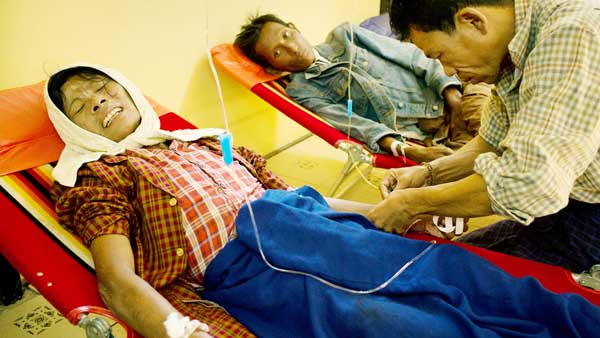
Xinhua,Yangon :
Intravenous injections have caused widespread HIV infection in Myanmar’s Sagaing region, local media quoted regional government Minister of Social Welfare Dr. Zaw Win as saying Sunday.
About 20.77 percent of HIV-infected patients got the infection due to drug injection, Zaw Win told a ceremony marking the World AIDS Day in Monywa, Sagaing region on Saturday, the official Global New Light of Myanmar reported on Sunday.
A total of 14 dispensaries in Sagaing are offering methadone to HIV patients and the regional government is providing supervision for conducting HIV blood test and education campaign for migrant workers, youths and prisoners, a region public health official also told the event.
Myanmar has launched a HIV/AIDS Flagship (UHF) project in five regions and states with the highest rate of HIV infection.
With a fund of 10 million U.S. dollars and backed by the United States Agency for International Development (USAID), the two-year project 2018-19 covers Kachin and Shan states and Sagaing, Yangon and Mandalay regions.
The project aims to scale up HIV prevention, testing and treatment services by utilizing non-governmental organizations and private sector health providers for people living with HIV and key population people who injected drugs, women sex workers, men and women who are afflicted and transgender people.
According to statistics, there are 224,794 people estimated to be living with HIV in Myanmar, which ranked 25 in the list of global countries having a high rate of HIV prevalence.
The rate of new patients with HIV infection dropped by 26 percent in 2016 from 2010, while the death toll due to AIDS-related disease plunged by 52 percent.
Ye is a Burmese doctor who worked for four years for Médecins Sans Frontières (MSF), the only provider of HIV treatment in the jade-mining area of Kachin State in the northernmost tip of Myanmar.
Workers from across Myanmar migrate there to work in the rich jade and gold mines, where they can earn four or five times as much as labourers in other provinces. And there are readily available temptations to spend those wages on: sex workers are plentiful and heroin is cheap. Kachin State is near the Golden Triangle, one of Asia’s most extensive areas of opium production, and heroin can be bought there for as little as a dollar (around 5-10 per cent of a miner’s daily wage).
These three factors – young workers detached from their family home, cheap heroin and widespread use of sex workers – have all contributed to a rampant HIV rate. One survey showed that nine out of ten drug addicts in the mining districts were HIV positive. Ye says that people are generally aware of the dangers of HIV but often ignore them, using heroin as a refuge to help them survive the extreme working conditions in the jade mines. Heroin ‘shooting galleries’, where the same needle can be used for many different clients, are increasingly replacing traditional opium dens. Meanwhile, long-running conflict in the area between the military and Kachin ethnic groups, combined with poor communications and transport, hampers testing and treatment efforts.
Almost 20 per cent of the people in Myanmar who inject drugs are now HIV positive, and the number of new diagnoses each year continues to rise. But for many other high-risk groups (including female sex workers, sex workers’ clients and men who have sex with men), the story is different. A 2013 report by UNAIDS showed that the numbers of new diagnoses are falling in these groups, as well as in the general population.
A 2011 government plan is trying to get new infections under control and provide antiretroviral therapy (ART) to more than 100,000 people nationwide by 2016 – an ambitious goal given that in 2013 the number was 68,000. The plan is supported by The Global Fund, an international financing organisation fighting AIDS, TB and malaria. Meanwhile, organisations such as MSF still provide treatment for around 60 per cent of people on ART in Myanmar. There are positive results: the estimated number of deaths caused by AIDS has decreased drastically, from almost 20,000 in 2010 to a projection of fewer than 12,000 in 2015.

